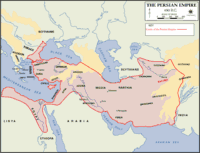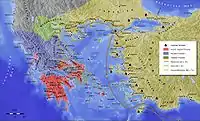Masistes
Masistes (Old Persian 𐎶𐎰𐎡𐏁𐎫, Maθišta; Greek Μασίστης, Masístēs; Old Iranian *Masišta[1]) (?- c. 478 BC) was a Persian prince of the Achaemenid Dynasty, son of king Darius I (reign: 520-486 BC) and of his wife Atossa, and full brother of king Xerxes I (reign: 486-465 BC). He was satrap (governor) of Bactria during his brother's reign, where he attempted to start a revolt in 478 BC.

Chief marshal

Masistes was one of the six chief marshals of the Greek campaigns of Xerxes (480-479 BC). Along with general Mardonius, he commanded the army column that crossed Thrace along the coast;[2] however, he was almost completely absent during the course of the war, including the battles of Salamis and Plataea.
He reappeared close to the end of the war, when he fought in the Battle of Mycale (479 BC). According to Herodotus, the battle was just about to take place at sea, but the Persians decided to come ashore in Ionia, Asia Minor, and fight on land.[3] The Greek and the Persian armies finally fought in Mycale, and the Persians were completely defeated. Commanders Tigranes and Mardontes died during the battle, but Artayntes and Itamithres, as well as Masistes, managed to escape. According to Herodotus, on their way to Sardis, where the king stayed, Masistes accused Artayntes of cowardice and blamed him of being "worse than a woman". In response, Artayntes unsheathed his sword and tried to kill Masistes, but was stopped by a Carian named Xenagoras of Halicarnassus.[4]
Masistes' family stayed near the battle, in Sardis, Lydia, which was a common practice of the nobility of the Persian Empire.[5] In Herodotus' Histories, he comments that while Masistes was fighting, his brother, king Xerxes, seduced Masistes' wife (see below).[6]
Love affairs and Masistes' revolt
The tale
Masistes is one of the main characters in a bloody episode in Herodotus' Histories (IX 108-110). Herodotus relates that, after his defeat in Greece, Xerxes fell in love with the wife of Masistes, but failed in all attempts to win her favour. In order to be closer to his sister-in-law, Xerxes married his son Darius to his niece Artaynte, a daughter of Masistes. The wedding was celebrated in Sardis, but when the court returned to Susa, Xerxes decided that he wanted the daughter rather than the mother, and Artaynte became his lover. One day, Xerxes visited Artaynte wearing a robe that had been woven by queen Amestris. He offered Artaynte to grant her whatever wish she desired. She chose the robe, and when she wore it in public, the affair was discovered.
When Amestris heard the news she sought revenge, not from Artaynte, strangely enough, but from her mother, the wife of Masistes. It was customary in Persia that on the king's birthday he had to grant all the wishes he was asked, so Amestris waited until that date to ask Xerxes to have Masistes' wife killed. Under Amestris' orders, Masistes' wife was tortured and mutilated: her breasts, nose, ears, lips and tongue were cut out. In the meantime, Xerxes offered Masistes the hand of one of his daughters. Masistes refused, and when he saw his mutilated wife he fled to Bactria to start a revolt; however, he was intercepted on his way by troops sent by the king, and put to death along with his followers and his three sons.
Historical background
The tale refers to an ill-fated attempt of Masistes to lead a revolt against his brother Xerxes. Although the exact date is unknown, it could not have happened too long after the battle of Mycale (479 BC), perhaps in 478 BC.[7]
It was originally considered that Xerxes, affected by his defeats in Greece, became involved in harem intrigues that would cause turmoil in the court and eventually result in the decadence and ruin of the Empire.[8] This view is widely criticised by more modern authors.[9] Many of the episode's themes appear in many legendary tales of Persian origin - the plot is the same, only the names of the characters are changed. Thus, although the tale is based on Persian oral accounts of Masistes' revolt, it is impossible to consider it as a historical fact and to derive literal conclusions from it.[10]
Relating to this, it has been argued that the royal robe (which Amestris wove for Xerxes in the story) was not just a piece of clothing but a symbol of the Persian monarchy.[11] According to this reasoning, and within the symbolic context of Persian culture of this period, when Artaynte asked Xerxes for his robe she was actually asking for the throne, although not for her, as she was married to the heir, prince Darius, but perhaps for her father Masistes. This could explain why Amestris punished Masistes' wife instead of her daughter Artaynte. It has also been noted that the punishment that Masistes' wife received was usually reserved for rebels.[12]
Other legendary Persian episodes share the theme of the royal robe, amongst these:
- Cyrus the Great receives the royal Mede robe when he marries the daughter of Mede king Astyages (Xenophon, Cyropaedia VIII 5 18).
- Cyrus the Younger is just about to kill his brother, king Artaxerxes II, but stops when he sees him dressing himself with the royal robe (Plutarch, Artoxerxes III 1-4).
- During a hunting expedition, nobleman Tiribazus wears the royal robe of king Artaxerxes II, causing disgust amongst his courtiers, as it is forbidden (Plutarch, Artoxerxes V 2).[13]
Masistes and mathishta
It has been noted that the name Masistes (which the Greek sources give) is related to the Old Persian title mathishta (maθišta, "the greatest", "the highest", "the longest"; "chief [of the troop]"; as a title, "the greatest after the king", "the second after the king") given to the royal heir designated by the king.[14] The problem lies in that the heir designated by Darius I is Xerxes, not Masistes, although the succession was not free of conflict. According to Herodotus, the eldest son by Darius was Artabazanes, but he had been born prior to Darius' ascent to the throne. Xerxes was the first-born son of Darius after he was crowned king, and he was also son of Atossa, the daughter of Cyrus the Great, founder of the empire. After many disputes in the court, Darius finally chose Xerxes. This is corroborated by Xerxes himself, who in his "Harem Inscription" of Persepolis states that his father designated him mathishta despite having other sons.[15]
Pompeius Trogus, a later author, relates the same story, but refers to Artabazanes as Ariamenes.[16] On the other hand, Plutarch states that Xerxes, when he is chosen as heir, offers Ariamenes the position of "second after the king".[17] The Ariamenes who appears in Plutarch, although he plays the role of the Artabazanes referred to by Herodotus and the Ariamenes referred to by Trogus, has similarities with Masistes. First, Ariamenes governs over Bactria in Plutarch's version, just as Masistes does in Herodotus. Also, the phrase "second after the king" coincides with the meaning of the title mathishta, which seems to be related to the name of Masistes.[18] However, in Plutarch, the "second after the king" refers to the most powerful person after the king himself, but not to the heir, as occurs with the title mathishta.[19]
It is possible, as it has been argued, that Masistes was not the real name of the younger brother of Xerxes, but simply his title, (mathishta).[20] Facing this possibility, it is important to note that Masistes was in fact a given name used at the time. In a clay cuneiform tablet ( a commercial document, specifically) from the Babylonian city of Nippur dated to 429 BC (during Artaxerxes I's reign) mention is made of a certain Masishtu (Masištu), whose name has been identified as the Akkadian form of Masistes.[21]
Notes
- Zadok & Zadok 1997, p. 5; Briant 1997, pp. 54, 91-92. The asterisk indicates that the name was reconstructed by modern scholars, and the sign "š" indicates the sound "sh". According to Ran Zadok, the name is of a non-Persic dialect origin.
- Histories VII 121
- Histories IX 107
- Burn 1962, pp. 333, 336, 337, 351; Dandamaev 1989, p. 253.; Green 1998, p. 283.
- Brosius 1998, p. 90
- Shrimpton 1997, p. 208.
- Lendering, a.
- Olmstead 1959 [1948], pp. 266-267.
- Such as, Sancisi-Weerdenburg 2005 [1983], pp. 28-30; Dandamaev 1989, p. 232; Brosius 1998, pp. 8-9; Wiesehöfer 2006 [2001], pp. 52-53.
- Sancisi-Weerdenburg 2005 [1983], pp. 28-30; Sancisi-Weerdenburg 2002.
- Eddy 1961, p. 93; Sancisi-Weerdenburg 2005 [1983] pp. 28-30.
- Sancisi-Weerdenburg 2005 [1983], p. 29. For example, in the Behistun Inscription: "Thereupon that Phraortes fled thence with a few horseman to a district in Media called Rhagae. Then I sent an army in pursuit. Phraortes was taken and brought unto me. I cut off his nose, his ears, and his tongue..." (quoted from Kent's translation )
- Eddy 1961, p. 93.
- Lendering b, with previous bibliography; García Sánchez 2005, pp. 8-9.
- Lendering, Jona. "Achaemenid Royal Inscriptions: XPf ("Harem inscription")". Livius.org Articles on ancient history. Livius.org. Retrieved 11 March 2015.
- Justin, Epitome of Philippic Histories of Pompeius Trogus, II 10 1-10
- Plutarch, Apophthegmata regum et imperatorum 1; De amore fraterno 18.
- Briant 2002, p. 524.
- García Sánchez 2005, pp. 7-8
- Lendering a.
- Zadok & Zadok 1997, p. 5; Briant 1997, pp. 54, 91-92.
References
- Briant, P (1997): "Bulletin d'Histoire Achéménide", in Topoi 1.
- Briant, P. (2002): From Cyrus to Alexander: A History of the Persian Empire, Eisenbrauns.
- Brosius, M (1998): Woman in Ancient Persia, Clarendon Press.
- Burn, AR (1962): Persia and the Greeks, St. Martin's Press.
- Dandamaev, M (1989): A Political History of the Persian Empire, Brill Academic Publishers, Leiden, trad. de W. Vogelsang.
- Eddy, SK (1961): The King Is Dead: Studies in the Near Eastern Resistance to Hellenism, 334-31 B. C, University of Nebraska Press.
- García Sánchez, M (2005): "La figura del sucesor del Gran Rey en la Persia Aqueménida", in V. Troncoso (ed.), Anejos Gerión 9, La figura del sucesor en las monarquías de época helenística.
- Green, P (1998): The Greco-Persian Wars, University of California Press.
- Shrimpton, GS (1997): History and Memory in Ancient Greece, McGill-Queens University Press.
- Lendering, J (a): "Atossa", in Livius.org
- Lendering, J (b): "Mathišta", in Livius.org
- Olmstead, ATE (1959) [1948]: History of the Persian Empire, University of Chicago Press, Chicago.
- Sancisi-Weerdenburg, H. (2002): "The Personality of Xerxes, King of Kings ", in Brill's Companion to Herodotus, Brill Academic Publishers, Leiden, originally published in L. de Meyer & E. Haerinck (eds.) Archaeologia Iranica et Orientalis Miscellanea in Honorem Louis Vanden Berghe Peeters, Gent, 1989, pp. 549–560.
- Sancisi-Weerdemburg, H (2005) [1983]: "Exit Atossa: Images of Woman in Greek Historiography on Persia", in A. Kuhrt & A. Cameron (eds.) Images of Woman in Antiquity, Routledge.
- Wiesehöfer, J (2006) [2001]: Ancient Persia from 550 BC to 650 AD, I. B. Tauris, translated by A. Azodi.
- Zadok, R; & T. Zadok (1997): "LB texts from the Yale Babylonian Collection", in NABU 1997-13.
